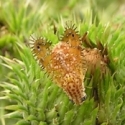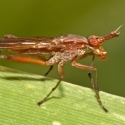Fruit Flies / Picture-winged flies / Marsh Flies
Fruit Flies (Tephritidae) range in size from approximately 1/16 – 5/8 inch in length. Many have intricately patterned wings which are said to be used in courtship, and in some species, as a deterrent to predation. Wing-waving apparently deters attacks from their main predator, jumping spiders. The larvae live in a variety of fruit and seeds. Some are leaf miners and some form galls. There are about 200 species and 55 genera north of Mexico.
Marsh Flies (Sciomyzidae) also known as Snail Killing Flies, range in size from 1/4 – 1/2 inch in length. They are recognized by a concave face and elongate antennae that extend forward. The larvae of all species are predators or parasites of molluscs. Most parasitize fresh water snails, but a few parasitize land snails, snail eggs or slugs. They are usually found on the margins of wetlands or roadside ditches. The larvae are aquatic. There are about 190 species in 12 genera in North America.
Picture-winged Flies (Ulidiidae) are approximately 3/8 – 1/2 inch in length and are named for the bold patterns on the wings. The larvae of most are scavengers on decaying organic matter, but a few are plant feeders. There are 133 species and 41 genera in North America. The family was formerly named Otitidae.
Disclaimer: The content of NatureSearch is provided by dedicated volunteer Naturalists of Fontenelle Forest who strive to provide the most accurate information available. Contributors of the images retain their copyrights. The point of contact for this page is: Loren Padelford.



